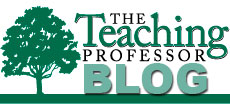 |
| Photo: The Teaching Professor Blog |
So they compiled a short survey that asks students what technology they’re expecting in the course, what learning activities they’re anticipating, what they’re thinking they’ll be graded on, their expectations regarding faculty-student interactions, and how soon they’re expecting faculty to answer emails, post grades, and/or return assignments and be available to meet with them. Here’s a link to the survey: http://bit.ly/1EXVUAi. Surveys like these are great idea generators. What course expectations do you and your students have?
 |
| The Teaching Professor Blog |
The idea here is not to find out what students expect and then provide it because that’s what they want. Rather, it’s about finding out if their expectations are correct and how well they align with yours. You may need to elaborate on your expectations or possibly modify course plans based on students’ expectations. It’s all about communication, and an activity like this helps to get everyone on the same page.
Designers tested the survey with 816 responses from undergraduates in 25 STEM courses. They included one other interesting feature. In each area of expectation, they asked students to rank whether the activity was important in terms of their learning. So if they expected the teacher to use PowerPoint, was it an important component in their learning? Their findings are noteworthy: “As a general trend, students placed greater value on learning tools available to them during their independent study time, such as study guides and textbooks, while they discounted the value of in-class activities (like discussion groups and in-class participation) for learning.” (p. 256)
Read more...
Source: Faculty Focus












